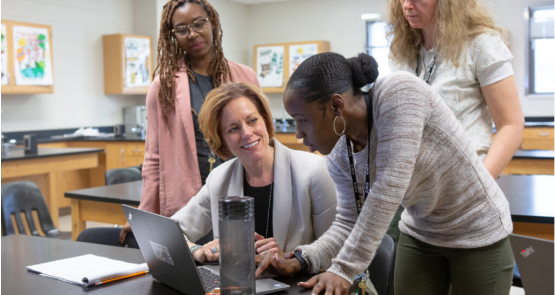6. Teaching Media Literacy: How to Help Students Navigate the News
Recent changes to the news have transformed media literacy education into an absolute necessity for today’s students. But when it comes to actually teaching media literacy, we are in many ways still at square one.
The changes to our information ecosystem have been disruptive. Pernicious sources of misinformation have cropped up, likely having some influence on democratic processes. Social media and ubiquitous tech have changed the way we consume news. And the media industry has undergone substantial shifts to its financial model that have degraded quality and encouraged siloing and groupthink.

Amidst all this upheaval, there have been calls for greater media literacy instruction in schools. It’s easy to see that, beginning at a young age, children need help learning to navigate the internet, avoid distractions, and evaluate sources of information. This is not just vital for the health of democratic culture and politics, but also, some research suggests, for their

Kids and Media Literacy
Media literacy education should begin at an early age because media consumption begins at an early age. By the age of 8, over 20 percent of kids already have their own smartphones, and by the age of 12, two-thirds do.
The impacts of smartphone use among children and preteens are still not well understood, and it can be difficult to distinguish aspects of a moral panic about tech from genuine problems with technology use.
Still, research from the National Institutes of Health suggests kids spending more than two hours a day performed worse on language and thinking tests. And other research continues to suggest links between tech use and higher rates of depression and suicide attempts among teens.
Although much of the responsibility for kids’ media use obviously falls on parents, educators have an important role to play too, especially in ensuring students’ thinking skills are augmented, rather than hindered, by their access to information.

One of the most difficult things for children and adults alike is figuring out how to intentionally and actively research and interpret media instead of passively consuming it. Passive consumption makes us more likely to be manipulated even by news sources that may be factual, but present information in a partial or misleading way.
Integrating Media Literacy Into Your Curriculum
Although new initiatives to foreground media literacy have begun in earnest, especially in the aftermath of the 2016 election, there is relatively little time or space in most curricula for explicit media literacy instruction, and standalone media literacy courses are still relatively rare.
Fortunately, media literacy can be integrated into different research projects in the curriculum, especially in writing, history, or civics lessons. And there are lots of exercises, discussions, and assignments teachers can construct in different contexts to help students improve their relationship to media. Media is omnipresent in students’ lives and, increasingly, in their studies too. Teaching media literacy the habits of healthy media consumption need not be confined, therefore, to media literacy courses.

Below are some suggestions for how to integrate media literacy into your curriculum:
1. Teach Students About How Media Influences Focus. Many students will enter middle and upper elementary school already well-versed in using technology including smartphones, but they may be less aware of how and why apps and social media websites are designed the way they are. An important step toward media literacy is recognition of the interests of advertisers, app designers, and other groups involved in students’ use of their phones.
Teachers can spend time with students talking about how and why these devices have been prized by advertisers, how they attempt to manipulate and maintain attention, and the various negative psychological impacts this can have, especially on young people.
Below are a set of articles, one or many of which teachers might organize a conversation around:
- “What It Takes to Put Your Phone Away,” Jia Tolentino, The New York Times
- “Can we trust the people who got us hooked on the internet to save us from it?” Kaitlyn Tiffany, Vox
- ·“‘The attention economy is in hyperdrive’: how tech shaped the 2010s,” Oliver Burkeman, The Guardian
- “How does technology impact teenagers’ brains? We still don’t have enough research to know.” Shirin Ghaffary, Recode
These articles cover topics that students should have a natural interest in, so it could be useful and productive to let them talk about them in small groups first. Teachers might make individual students responsible for summarizing the arguments and/or information offered in each article. They could then open up class discussion to more personal concerns and ideas, for example asking students questions like:
- Do you notice your attention span and anxiety levels increasing from spending a lot of time online or on social media?
- Do you use any tools or strategies to prevent yourself from getting distracted online? Why or why not?
- Do you think tech companies or the government have a responsibility to regulate addictive and manipulative features of the internet?
- Do you think the internet has had an overall negative or positive impact on society and culture? Politics? Personal relationships?
- What is media literacy? What does it mean to you? Do you consider yourself media literate?
These kinds of discussions will help students see themselves, metacognitively, as media consumers who need to be careful and intentional about how they navigate the internet and consume information. This is a necessary first step to more careful engagement with media.

2. Encourage Students to Read Laterally. One very significant challenge in teaching media literacy is giving students the skills to challenge and verify information without making them cynical and untrustworthy about all information, even that coming from high-quality sources.
One of the most important ways to do this is through what some media literacy researchers have dubbed “lateral reading.” This means interrogating information from a single source by trying to verify or refute it through other — known and reliable — sources.
The Civic Online Reasoning curriculum at Stanford University includes lessons on lateral reading, helping students to interrogate, for example, a tweet from an unreliable source by opening up new browser tabs and looking for information from other more reliable sources.

Practice in lateral reading teaches students how to step back from single sources (“reading vertically”) to see the broader picture. The practice will also teach them that there are often no simple answers to analyzing information online. No source is perfectly reliable, nor without some kind of bias.
This doesn’t mean, of course, that everything is to be automatically distrusted, but just that reasoning, especially in this complex information environment, requires a great deal of good judgment, independence, and willingness to do the research.
3. Engage in Media Analysis. As they gain skills in lateral reading, teachers can introduce more complex assignments in middle and high school on reasoning through matters of opinion and complex policy analysis. For example, teachers could have students read this article, by President Trump’s Chief Economic Advisor at the time Gary Cohn, on the tax reform bill that passed in 2017.
Depending on the stage of their students’ media literacy skills, teachers might then have students conduct and synthesize research independently on the promises and effects of the tax cut. Or they might give them a selection of articles from different ideological perspectives to read.
Specifically, a teacher could give their students these articles:
- “How FedEx Cut Its Tax Bill to $0,” The New York Times
- “America Is Competitive Again,” Gary D. Cohn, The Wall Street Journal
- “How Trump Turned Tax Day Into a Giveaway for the One Percent,” Mother Jones
- “This is how much American workers saved during the first year after Trump tax overhaul,” Marketwatch
- “Let the dust settle on the TCJA before judging its effectiveness,” American Enterprise Institute
- “A New Congressional Study Finds Little Economic Benefit From The 2017 Tax Cuts,” Tax Policy Center
Class discussion about these articles can be organized around questions that drive students to reflect at a deeper level on the assumptions and behind these stories. Questions might include:
- Analyze the rationale for passing tax reform. What are the different reasons the president and Republican lawmakers support the law?
- What are defenders and critics of the bill saying now? What evidence do they cite for their arguments?
- On balance, which arguments do you think are more convincing? Why?
The class discussion might then lead into an analytical writing assignment. As the students analyze these sources, they should concentrate on a few things:
- Checking for bias: Examining the reliability and biases of the sources. What makes them think sources are reliable or unreliable? What perspective does each source come from? What biases does each potentially bring to the issue?
- Framing and rhetoric: How do these stories frame their analysis, using anecdotes or facts, for example. Do they appeal to emotions or reason? Do they engage with opposing points of view persuasively?
What’s missing? Often a news or opinion piece will avoid facts that complicate or contradict its position. Students should be on the look-out for what goes missing and what that says about the message of the piece.
Sources and Resources
Civic Online Reasoning, Stanford University.
Free collection of lessons from the Stanford History Education Group.
De Abreu, B. S., Mihailidis, P., Lee, A. Y., Melki, J., & McDougall, J. (Eds.). (2017). International Handbook of media literacy education. Taylor & Francis.
Overview of the history and current state of media literacy from leading scholars of the subject. Discusses media literacy education, civic engagement, and media production as a component of media literacy.
De Abreu, B. S. (2019). Teaching media literacy. American Library Association.
Discusses impact of new media and technology on K-12 students. Includes lesson plans and activities.
Wineburg, S., McGrew, S., Breakstone, J., & Ortega, T. (2016). Evaluating information: The cornerstone of civic online reasoning. Stanford Digital Repository.
In-depth study of student media literacy skills in middle and high school.



